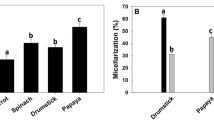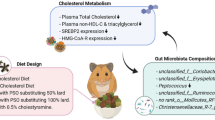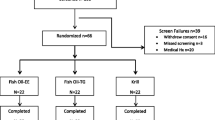Abstract
Improving the bioavailability of β-carotene is vital to manage vitamin A deficiency. The influence of micellar oleic (OA), linoleic (LA) and eicosapentaenoic (EPA) acids on plasma β-carotene response and its conversion to retinol has been studied in rats employing single (9 h time course) and repeated (10 days) dose administrations. After a single dose, the levels (area under the curve) of plasma β-carotene and retinyl palmitate in OA and EPA groups were higher (p < 0.05) by 13, 7 and 11, 6 folds than LA group. The liver β-carotene level in OA and EPA groups were higher (p < 0.05) by 3 and 1.2 folds than LA group. After repeated dose, the plasma β-carotene and retinyl palmitate levels in OA (6.2%, 51.7%) and EPA (25.4%, 17.23%) groups were higher (p < 0.05) than LA group. The liver β-carotene level in OA (21.2%) and EPA (17.6%) groups were higher (p < 0.05) than LA group. In both the experiments, the activity of β-carotene 15,15′-dioxygenase in the intestinal mucosa and plasma triglyceride levels were also higher in OA and EPA groups than LA group. β-Carotene excreted through urine and feces of OA and EPA groups was lower than the LA group. These results demonstrate an improved absorption and metabolism of β-carotene when fed mixed micelles with OA or EPA compared with LA. Although the mechanism involved in selective absorption of fatty acids needs further studies, intestinal β-carotene uptake and its conversion to vitamin A can be modulated using specific fatty acids.
Similar content being viewed by others
References
Mayne ST: β-Carotene, carotenoids and disease prevention in humans. FASEB J 10: 690–701, 1996
Olson JA: Vitamin A and carotenoids as antioxidants in a physiological context. J Nutr Sci Vitaminol 39: S57–S65, 1993
Krinsky NI: Mechanism of action of biological antioxidants. Proc Soc Exp Biol Med 200: 248–254, 1992
Jayarajan P, Reddy V, Mohanram M: Effect of dietary fat on absorption of β-carotene from green leafy vegetables in children. Indian J Med Res 71: 53–56, 1980
Tyssandier V, Reboul E, Dumas JF, et al: Processing of vegetable-borne carotenoids in the human stomach and duodenum. Am J Physiol Gastrointest Liver Physiol 284: G913–G923, 2003
Dimitrov NV, Meyer C, Ulrey DE, Chenoweth W, Michelakis A, Malone W, Boone C, Fink G: Bioavailability of β-carotene in humans. Am J Clin Nutr 48: 298–304, 1988
Furr HC, Clark RM: Intestinal absorption and tissue distribution of carotenoids. J Nutr Biochem 8: 364–377, 1997
Olson JA: Absorption, transport and metabolism of carotenoids in humans. Pure Appl Chem 66: 1011–1016, 1994
Jalal F, Nesheim MC, Agus Z, Sanjur D, Habicht JP: Serum retinol concentrations in children are affected by food sources of β-carotene, fat intake, and anthelmintic drug treatment. Am J Clin Nutr 68: 623–629, 1998
Jalal F: Effects of deworming, dietary fat and carotenoid rich diets on vitamin A status of preschool children infected with Ascaris lumbricoides in West Sumatra province, Indonesia. Ph. D. dissertation. Cornell University, Ithaca, NY, 1991
Roels OA, Trout M, Dujacquier R: Carotenoid balances on boys in Rwanda where vitamin A deficiency is prevalent. J Nutr 65: 115–127, 1958
Borel P, Tyssandier V, Mekki N, Grolier P, Rochette Y, Alexandre-Gouabau MC, Azais-Braesco: Chylomicron β-carotene and retinyl palmitate responses are dramatically diminished when men ingest β-carotene with medium-chain rather than long-chain triglycerides. J Nutr 128: 1361–1367, 1998
Hollander D, Ruble PE: β-Carotene intestinal absorption: bile, fatty acids, pH and flow rate effects on transport. Am J Physiol 235: E686–E691, 1978
Nkondjock A, Ghadirian P: Intake of specific carotenoids and essential fatty acids and breast cancer risk in Montreal, Canada. Am J Clin Nutr 79: 857–864, 2004
Baskaran V, Sugawara T, Nagao A: Phospholipids affect the intestinal absorption of carotenoids in mice. Lipids 38: 705–711, 2003
Raju M, Lakshminarayana R, Krishnakantha TP, Baskaran V: Influence of phospholipids on β-carotene absorption and conversion into vitamin A in rats. J Nutr Sci Vitaminol 51: 216–222, 2005
Hernell O, Staggers JE, Carey MC: Physical-chemical behavior of dietary and biliary lipids during intestinal digestion and absorption. 2. Phase analysis and aggregation states of luminal lipids during duodenal fat digestion in healthy adult human beings. Biochemistry 29: 2041–2056, 1990
Staggers JE, Hernell O, Stafford RJ, Carey MC: Physical-chemical behavior of dietary and biliary lipids during intestinal digestion and absorption. 1. Phase behavior and aggregation states of model lipid systems patterned after aqueous duodenal contents of healthy adult human beings. Biochemistry 29: 2028–2040, 1990
Fletcher MJ: A Colorimetric Method for Estimating Serum Triacylglycerol. Clin Chim Acta 22: 303–307, 1968
Nagao A, During A, Hoshino C, Terao J, Olson JA: Stoichiometric conversion of all-trans β-carotene to retinal by pig intestinal extract. Arch Biochem Biophys 328: 57–63, 1996
Phillips GM, Taylor PJ: Theory and applications of numerical analysis. New York: Academic Press, pp 120–153, 1978
O'Neill ME, Thurnham DI: Intestinal absorption of β-carotene, lycopene and lutein in men and women following a standard meal: response curves in the triacylglycerol-rich lipoprotein fraction. Br J Nutr 79: 149–159, 1998
Van Vliet T, Schreurs WH, Van den Berg H: Intestinal β-carotene absorption and cleavage in men: response of β-carotene and retinyl esters in the triglyceride-rich lipoprotein fraction after a single oral dose of β-carotene. Am J Clin Nutr 62: 110–116, 1995
Hu X, Jandacek RJ, White WS: Intestinal absorption of β-carotene ingested with a meal rich in sunflower oil or beef tallow: postprandial appearance in triacylglycerol-rich lipoproteins in women. Am J Clin Nutr 71: 1170–1180, 2000
Van het Hof KH, West CE, Weststrate JA, Hautvast JGAJ: Dietary factors that affect the bioavailability of carotenoids. J Nutr 130: 503–506, 2000
Coiffier E, Paris R, Lecerf J: Effects of dietary saturated and polyunsaturated fats on lipoprotein lipase and hepatic triglyceride lipase activity. Comp Biochem Physiol B. 88: 187–192, 1987
Ockner RK, Manning J: Fatty acid binding protein: role in esterification of absorbed long chain fatty acid in rat intestine. J Clin Invest 58: 632–641, 1972
During A, Nagao A, Terao J: β-carotene 15,15′-dioxygenase activity and cellular retinol-binding protein type II level are enhanced by dietary unsaturated triacylglycerols in rat intestines. J Nutr 128: 1614–1619, 1998
Hussain MH: A proposed model for the assembly of chylomicrons. Atherosclerosis 148: 1–15, 2000
Van Greevenbroek MMJ, Van Meer G, Erkelens DW, De Bruin TWA: Effects of saturated, mono- and polyunsaturated fatty acids on secretion of apoB containing lipoproteins by Caco-2 cells. Atherosclerosis 121: 139–150, 1996
Jackson KG, Robertson MD, Fielding BA, Frayn KN, Williams CM: Olive oil increases the number of triacylglycerol-rich chylomicron particles compared with other oils: an effect retained when a second standard meal is fed. Am J Clin Nutr 76: 942–949, 2002
De Bruin TW A, Brouwer CB, Van Linde-Sibensius Trip M, Jansen H Erkelens DW: Different postprandial metabolism of olive oil and soybean oil: a possible mechanism of the high-density lipoprotein conserving effect of olive oil. Am J Clin Nutr 58: 477–483, 1993
Higashi K, Toshitsugu T, Shige H, et al: Olive oil increases the magnitude of postprandial chylomicron remnants compared with milk fat and safflower oil. J Am Coll Nutr 16: 429–434, 1997
Rahman MH, Avella MA, Botham KM: The fatty acid composition of chylomicrons influences the rate of their lipolysis in vivo. Nutr Metab Cardiovasc Dis 10: 121–125, 2000
Borel P, Grolier P, Armand M, Partier A, Lafont H, Lairon D, Azais-Braesco V: Carotenoids in biological emulsions: solubility, surface-to-core distribution and release from lipid droplets. J Lipid Res 37: 250–261, 1996
Author information
Authors and Affiliations
Corresponding author
Rights and permissions
About this article
Cite this article
Raju, M., Lakshminarayana, R., Krishnakantha, T.P. et al. Micellar oleic and eicosapentaenoic acid but not linoleic acid influences the β-carotene uptake and its cleavage into retinol in rats. Mol Cell Biochem 288, 7–15 (2006). https://doi.org/10.1007/s11010-005-9091-5
Received:
Accepted:
Published:
Issue Date:
DOI: https://doi.org/10.1007/s11010-005-9091-5




